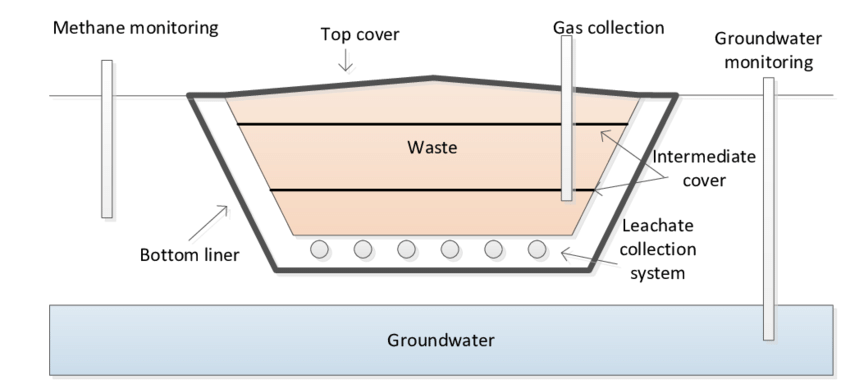Sanitary Landfilling
“
— ”
Sanitary landfills are designated sites where various forms of waste are collected and isolated from the rest of the environment until completely degraded biologically, chemically and physically. Four basic conditions need to be adopted in order to make a sanitary landfill. The site selected should preferably contain leachate security and if not, additional soil lining should be provided to reduce leakage from the base which could contaminate the groundwater and surrounding soil. Design of the landfill should be developed from geological and hydrogeological conditions with proper waste disposal and restoration plans in place. Trained staff should supervise the landfill site and ensure its regular operation and maintenance, and waste should be layered, compacted, covered daily to keep pests and vermin away.1
South Africans generate roughly fifty-four-point-two million tons of municipal, commercial, and industrial waste per year, and out of this, only a maximum of ten percent of waste is recycled or recovered for other uses.2 Sanitary landfilling is a generally accepted way of disposing waste in an economical and safe way. The province of Gauteng licensed a new landfill site for recycling and recovery of waste in 2017 in the Orange Farm area.3 Most landfill sites, however, are filling up and approaching closure at an increasingly rapid rate, and there have not been viable alternatives generated to tackle this situation. Additionally, multiple landfill sites do not comply with health and safety regulations, creating a health hazard for the surrounding neighborhood. It can be said that South Africa is at least fifteen years behind the most developed countries of the European Union in implementing the required waste recovery system which would create economically viable business and employment.4

Image source:
The major design components of a landfill based on Vesilind et al.
References
1. Thurgood, Maggie. Solid Waste Landfills: Decision-Makers Guide Summary.1999, World Bank, World Health Organization, Swiss Agency for Development and Cooperation, and Swiss Center for Development Cooperation in Technology and Management.
2. AWARD. “South Africa Is Drowning in Its Own Waste – Are Our Regulators Taking This Crisis Seriously?,” February 1, 2019. http://award.org.za/index.php/2019/02/01/south-africa-is-drowning-in-its-own-waste-are-our-regulators-taking-this-crisis-seriously/
3. “South African Waste Information Centre.” Accessed March 20, 2022. http://sawic.environment.gov.za/?menu=88.
4. Same as 72
1. Thurgood, Maggie. Solid Waste Landfills: Decision-Makers Guide Summary.1999, World Bank, World Health Organization, Swiss Agency for Development and Cooperation, and Swiss Center for Development Cooperation in Technology and Management.
2. AWARD. “South Africa Is Drowning in Its Own Waste – Are Our Regulators Taking This Crisis Seriously?,” February 1, 2019. http://award.org.za/index.php/2019/02/01/south-africa-is-drowning-in-its-own-waste-are-our-regulators-taking-this-crisis-seriously/
3. “South African Waste Information Centre.” Accessed March 20, 2022. http://sawic.environment.gov.za/?menu=88.
4. Same as 72